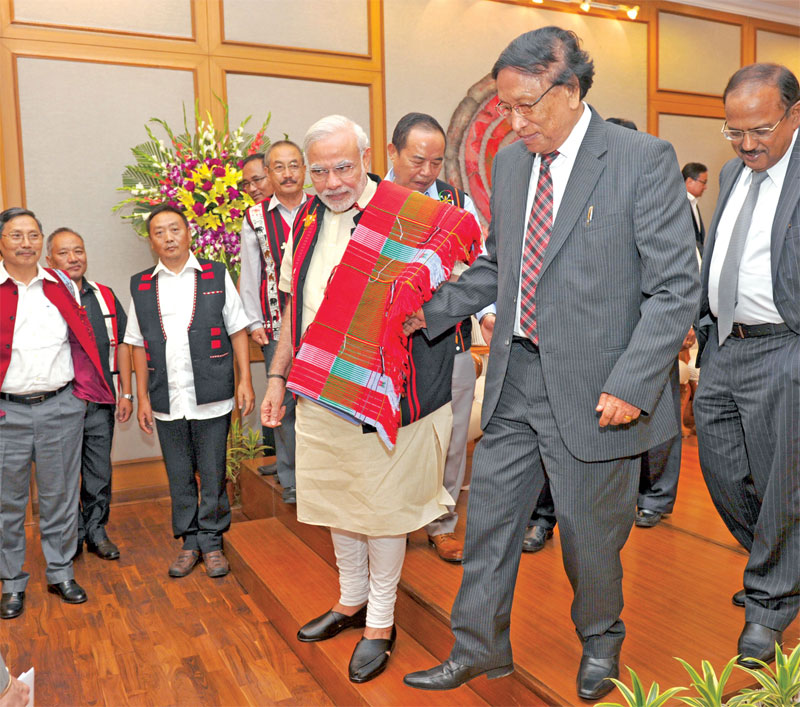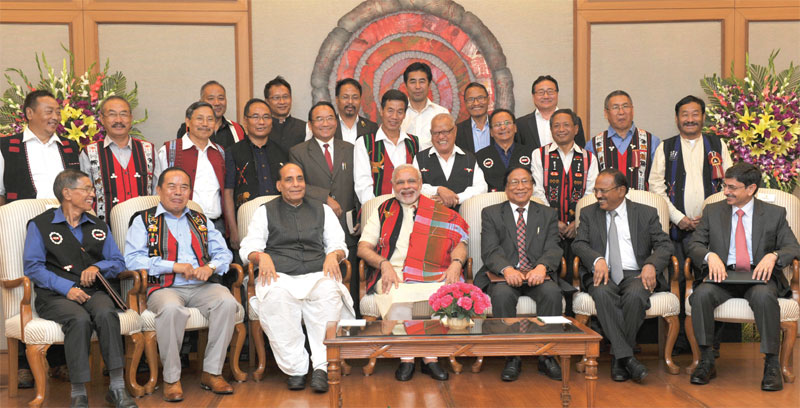An attractive economic package can achieve what the Indo-Naga peace process couldn’t
Nandita Haksar
The Indo-Naga peace process remains shrouded in mystery both for the Naga and the rest of the Indians. I have been associated with the peace process; but not officially. It has been in my capacity as a human rights lawyer that I learnt the workings of the peace process.

On 3 August 2015, the government of India and the National Socialist Council of Nagalim (NSCN (IM)) signed what has been called the Indo-Naga Framework Agreement. Again, for months there was speculation on the contents of the Framework Agreement. Two versions of the Framework Agreement have been released—one apparently released by N. Ravi, the last interlocutor and now governor of Nagaland state, and another ‘original’ version by the NSCN.
Now that the contents of the Framework Agreement have become public, it will be obvious that it has nothing much to offer by way of resolution to the peace process. From the beginning, the peace process has lacked transparency. Both parties have, for their respective reasons, developed a vested interest in keeping the process a mystery so they could misrepresent it to serve their interests.
There are two reasons why the peace talks were remarkable and a historical milestone in the history of Indian democracy.
- It began as a genuine political process with the possibility of a negotiated political settlement which could have set a precedent for dealing with other insurgencies.
- The fact that the insurgents were allowed to carry their arms and had designated camps ensured that the Nagas had bargaining power and were not humiliated by having to surrender.
How It All Began
The origin of the peace process is rooted in a dinner party at the home of a senior Naga police officer, Peter Chiphang. He had invited Deepak Dewan, the editor of the North East Sun, a weekly, and Grinder Muivah, the nephew of Th Muivah, the general secretary of the NSCN.
Dewan, like all journalists was after a scoop. He wanted to be the first to interview Th Muivah who had been underground for almost 30 years. Grinder helped him get that interview and after reading the interview, Muivah gave Grinder permission to contact minister Rajesh Pilot.
As a result of these meetings in July 1995 P.V. Narasimha Rao, the then Indian prime minister, met the two NSCN leaders in Paris. And finally, in 1997 the NSCN leaders and the government of India resolved to sit across and discuss the possibility of peace. The Indian Parliament was informed and the process began.
Modalities of Peace Process
The peace process was based on three basic conditions:
- The peace talks will be unconditional. By this it meant there would not be talk of having an arrangement within the Constitution of India.
- The talks would be held at the highest level. In other words, the negotiators would be a person directly responsible to the Indian prime minister. On the Naga side, Th Muivah would hold the position of prime minister in the Naga underground government.
- The talks would be held outside India.
- There would be an elaborate mechanism for maintaining a ceasefire. With some conditions, the Naga Army was allowed to carry arms and have its camps, which were to be designated.
Manipur Factor
The first person appointed to carry out the negotiations was Swaraj Kaushal, a lawyer and politician, who had handled the Mizo peace process successfully. Kaushal was successful in winning the trust of the NSCN leaders, but he was removed, in part because he agreed that the ceasefire should extend ‘without territorial limits.’ This meant that ceasefire would operate in Manipur, a major theatre of operation for the NSCN.
But for Manipur state, the extension of the ceasefire to Manipur was a de facto recognition that the Naga-inhabited areas of the state were a part of Nagaland. For the Nagas, ‘Nagaland’ did not mean the state of Nagaland but all areas inhabited by the Nagas, which included parts of Assam, Manipur, Arunachal and Nagaland state; and also parts of Myanmar.
India called this a demand for ‘greater Nagaland’. The Nagas called it a demand for ‘Nagalim’.
The Constitution gives absolute powers to the Centre to change boundaries of the states without consulting the state governments. Three states, Jharkhand, Chhattisgarh and Uttarakhand had been created by bifurcating Bihar, Madhya Pradesh and Uttar Pradesh.
However, Manipur has a different history. It was an ancient kingdom, not merely an administrative unit. The majority community, the Meiteis, said they would not tolerate any threat to the unity and integrity of their territory. They said the so-called Naga-inhabited parts of Manipur had always been a part of the ancient kingdom of Manipur.
The peace process got stuck over the issue of extension of the ceasefire to Manipur. But it was not so much about a ceasefire as about the position of Nagas living in Manipur’s hill districts.
Role of Intelligence Agencies
From the beginning, the intelligence agencies played a major role in disrupting the talks. According to a 2014 article in the New Indian Express, even the success in the negotiations with the Mizo insurgents has been attributed to Ajit Doval’s contribution in ‘in eliminating and effecting the surrender of important insurgent leaders’.
In India there is no authority which oversees intelligence agencies; their working and funding remains secret. In 2000, the intelligence agencies had Muivah arrested by Thai police after they informed them that he was travelling under a false name and holding a Korean passport. Muivah was coming from Pakistan to Bangkok for the peace talks.
The arrest of Muivah in Bangkok was followed by the arrest of Grinder Muivah in Kolkata. By this time Grinder had been appointed as the official go-between for the talks. Grinder Muivah was arrested on an absurd charge that he was trying to hijack a plane from Mizoram to rescue Muivah in Bangkok. I went to Kolkata and then to Aizawl to file for bail for Grinder. It was then I saw for myself how the intelligence agencies work to disrupt the peace process. I got Grinder out on bail and he came to some arrangement with the intelligence agencies, so he withdrew his case against the attempt to frame him in a patently false case.
Three former prime ministers of India signed an appeal to the Thai authorities asking that Muivah be released so the peace talks could resume. I put the letter on record in the Thai courts. The peace talks did resume. The Indian intelligence agencies managed to get the NSCN to agree to hold all further talks within India.
Pan-Naga Body
Kaushal was replaced by K. Padmanabhaiah as the interlocutor. He was there from 1999 to 2010. During this period, first Th Muivah was arrested; then Grinder Muivah and subsequently, nothing was achieved in terms of concretisation of their demands.
Neither the Nagas nor the Indians put forward any substantial document on which the negotiations could take place. The NSCN was being advised by Michael Van Walt, a Dutch lawyer who has been an advisor to the Dalai Lama. He did not have knowledge of the Indian Constitution and the NSCN refused to read the Indian Constitution on principle. They wanted a solution ‘outside’ the frame of the Indian Constitution.
In 2010, Padmanabhaiah was replaced with another interlocutor, R.S. Pandey who had been chief secretary in Nagaland. It was he who put forward a non-Plan which had some concrete proposals. The non-Plan suggested the possibility of a pan-Naga body which could unite all the Nagas in different states without changing the borders of the existing states.
What exactly this would mean was not clear. In 2011, the NSCN invited a group of lawyers from various parts of the world (with the approval of the Indian government) to look at the non-Plan and work out the way it could be converted into a document on the basis of which the NSCN could negotiate.
The group of lawyers met in Delhi. The lawyers included Anthony Reagen, an Australian lawyer who had negotiated for a similar settlement in Papua New Guinea. The senior-most lawyer amongst us was Prof. Yash Ghai, who a year before, had successfully drafted the new Constitution for Kenya. He was a personal friend of Prime Minister Manmohan Singh and the prime minister had hoped that he could help bring about a resolution to the Indo-Naga conflict.
My husband and I were deeply involved in the deliberations during the two days of intense discussions. At the end of the two-day long deliberations we produced a detailed document. It got a positive response from the NSCN leaders. There was talk that the document would be made public so the Nagas could debate over the contents.
But the document never saw the light of day. A subsequent meeting in 2015 after the Framework Agreement was a fiasco mainly because none of the lawyers who had been involved in the first one were present.

The Indo-Naga Peace Process has Failed
The Framework Agreement of 3 August 2015 has nothing to offer. And now the talks seem to have got stuck around the NSCN insistence on having their own flag and constitution. Even if such a demand is agreed to, there is no guarantee that the Agreement will be honoured. We have the example of Sikkim which joined the Indian Union as an associate state and within a year it was made into a full-fledged state. And Kashmir, which had its own flag and constitution, but the constitutional promises were betrayed when Article 370 and Article 35A were made non-operational.
Can anything come out of the peace talks at all? The only thing that can be achieved is a good economic package which will bring some real development to the Naga inhabited areas which are some of the remotest in the country. There are villages where there is no electricity, no water and no toilets. A whole generation of Naga youth have left and taken jobs all over India; many have returned penniless in the wake of the pandemic.
Instead of thinking about the welfare of the people, the intelligence agencies are playing havoc by promoting tribalism and divisions. The NSCN is now divided into at least five separate groups. They have used the period to arm themselves and to extort money from their people. The Naga people are getting alienated from both the NSCN and the government of India. They are turning to religion and there is a growing fundamentalism, where all outsiders and even minorities within Naga society are not tolerated. The vision of a future Naga nation is theocratic and based on race and religion.
The growing intolerance of minorities within India is feeding the intolerance among Nagas.
(The writer is a human rights lawyer and author of several books. Her most recent book is Kuknalim, Naga Armed Resistance: Testimonies of Leaders, Pastors, Healers and Soldiers)

